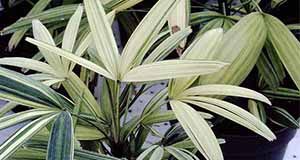Rhapsis excelsa, the lady palm, is an outstanding, small clustering palm for shady landscape or interiorscape use. This two page fact sheet gives a brief overview of the Lady Palm. Written by Timothy K. Broschat and published by the Environmental Horticulture Department.
http://edis.ifas.ufl.edu/fp501
Tag: Arecaceae (taxonomic family)
Adonidia merrillii: Christmas Palm
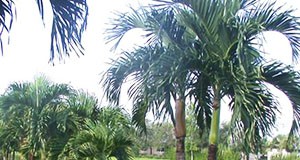
The Christmas palm (Adonidia merrillii) is a fast-growing palm that is well-suited for small sites, requires little maintenance, is relatively disease-free, and produces clusters of bright red fruit in winter, hence the common name Christmas palm. This 2-page fact sheet covers the Christmas palms biology, distribution and habitat, susceptibility to disease, and general care. Written by Timothy K. Broschat, and published by the UF Department of Environmental Horticulture, July 2015.
http://edis.ifas.ufl.edu/st658
Butia odorata: Pindo Palm
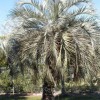 The pindo or jelly palm is a small, single-stemmed, feather-leaved palm widely grown in warmer parts of the US due to its unusual cold tolerance. It is considered hardy down to about 10°F (USDA zone 8A). The palm is slow-growing, eventually reaching 15 to 20 feet, making it suitable for planting under power lines. This 2-page fact sheet was written by Timothy K. Broschat, and published by the UF Department of Environmental Horticulture, February 2014.
The pindo or jelly palm is a small, single-stemmed, feather-leaved palm widely grown in warmer parts of the US due to its unusual cold tolerance. It is considered hardy down to about 10°F (USDA zone 8A). The palm is slow-growing, eventually reaching 15 to 20 feet, making it suitable for planting under power lines. This 2-page fact sheet was written by Timothy K. Broschat, and published by the UF Department of Environmental Horticulture, February 2014.
http://edis.ifas.ufl.edu/st105
Bismarckia nobilis: Bismarck Palm
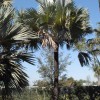 The Bismarck palm is a native of Madagascar that grows to a height of 30 to 60 feet with a spread of 12 to 16 feet. The massive 4-foot-wide costapalmate leaves are typically silver-green in color, but a light olive-green-leaved variety also exists. The persistent leaf bases are split, creating an attractive pattern on the 15–18-inch-diameter trunks. The dark brown male and female inflorescences are produced on separate trees, with females developing olive-brown fruit about 1.5 inches in diameter. The bold texture and color and eventual great height of this species make a strong statement in any setting, but can be overpowering in small residential landscapes. This 3-page fact sheet was written by Timothy Broschat, and published by the UF Department of Environmental Horticulture, February 2015. (Photo credit: T. K. Broschat)
The Bismarck palm is a native of Madagascar that grows to a height of 30 to 60 feet with a spread of 12 to 16 feet. The massive 4-foot-wide costapalmate leaves are typically silver-green in color, but a light olive-green-leaved variety also exists. The persistent leaf bases are split, creating an attractive pattern on the 15–18-inch-diameter trunks. The dark brown male and female inflorescences are produced on separate trees, with females developing olive-brown fruit about 1.5 inches in diameter. The bold texture and color and eventual great height of this species make a strong statement in any setting, but can be overpowering in small residential landscapes. This 3-page fact sheet was written by Timothy Broschat, and published by the UF Department of Environmental Horticulture, February 2015. (Photo credit: T. K. Broschat)
http://edis.ifas.ufl.edu/st101
Howea forsteriana: Kentia Palm
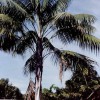 The kentia palm is considered one of the best interior palms for its durability and elegant appearance. The dark green graceful crown of up to three dozen leaves gives it a tropical appearance. Containerized palms can be used on a deck or patio in a shady location or the palm can be planted into the landscape.This 3-page fact sheet was written by Samar Shawaqfeh and Timothy Broschat, and published by the UF Department of Environmental Horticulture, January 2015. (Photo credit: T. K. Broschat)
The kentia palm is considered one of the best interior palms for its durability and elegant appearance. The dark green graceful crown of up to three dozen leaves gives it a tropical appearance. Containerized palms can be used on a deck or patio in a shady location or the palm can be planted into the landscape.This 3-page fact sheet was written by Samar Shawaqfeh and Timothy Broschat, and published by the UF Department of Environmental Horticulture, January 2015. (Photo credit: T. K. Broschat)
http://edis.ifas.ufl.edu/st297
Acoelorrhaphe wrightii: Paurotis Palm
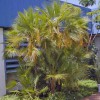 The paurotis or Everglades palm is a clustering, fan-leaved palm with very slender stems. It can reach heights up to 30 feet, with a spread of 20 feet. The light green leaves have blades about 2 feet across on spiny petioles up to 3 feet long. The stems are covered with fibers and persistent leaf bases. In the spring paurotis palms produce large inflorescences of creamy white flowers that extend well beyond the foliage. These are followed in the summer by ¼-inch round fruits that pass through green and orange stages but turn black when completely ripe. Paurotis palms are rather slow-growing and are not tolerant of salt spray. This 3-page fact sheet was written by Timothy K. Broschat, and published by the UF Department of Environmental Horticulture, September 2014.
The paurotis or Everglades palm is a clustering, fan-leaved palm with very slender stems. It can reach heights up to 30 feet, with a spread of 20 feet. The light green leaves have blades about 2 feet across on spiny petioles up to 3 feet long. The stems are covered with fibers and persistent leaf bases. In the spring paurotis palms produce large inflorescences of creamy white flowers that extend well beyond the foliage. These are followed in the summer by ¼-inch round fruits that pass through green and orange stages but turn black when completely ripe. Paurotis palms are rather slow-growing and are not tolerant of salt spray. This 3-page fact sheet was written by Timothy K. Broschat, and published by the UF Department of Environmental Horticulture, September 2014.
http://edis.ifas.ufl.edu/st058
Roystonea regia: Royal Palm
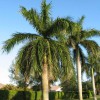 The royal palm is a large majestic palm that is native to south Florida and Cuba. It is considered cold hardy to about 28°F or USDA Cold Hardiness Zone 10A. This species quickly grows to heights of 50–70 ft., with a spread of 20–25 ft., and has a smooth light gray trunk up to 2 ft. in diameter. It is ideal for landscaping streets, parks, and commercial properties, but becomes too large for typical residential landscapes. This 4-page fact sheet was written by T.K. Broschat, and published by the UF Department of Environmental Horticulture, February 2014.
The royal palm is a large majestic palm that is native to south Florida and Cuba. It is considered cold hardy to about 28°F or USDA Cold Hardiness Zone 10A. This species quickly grows to heights of 50–70 ft., with a spread of 20–25 ft., and has a smooth light gray trunk up to 2 ft. in diameter. It is ideal for landscaping streets, parks, and commercial properties, but becomes too large for typical residential landscapes. This 4-page fact sheet was written by T.K. Broschat, and published by the UF Department of Environmental Horticulture, February 2014.
http://edis.ifas.ufl.edu/st574
Livistona chinensis: Chinese Fan Palm
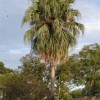 The Chinese fan palm is relatively slow growing, typically reaching about 30 feet in height. Its fan-shaped, costapalmate leaves can be 3 to 4 feet across and up to 6 feet long. Petioles of juvenile palms are spiny, but have few or no spines in adult palms. Because of its gracefully drooping leaf segment tips, this species is sometimes called the “fountain palm”. Young specimens are slow to form a trunk, which has led to the unfortunate practice of planting these palms close together as a ground cover. Eventually, most of those closely planted palms will have to be removed to accommodate their 10 to 12 foot spread. This 5-page fact sheet was written by Timothy K. Broschat, and published by the UF Department of Environmental Horticulture, April 2014.
The Chinese fan palm is relatively slow growing, typically reaching about 30 feet in height. Its fan-shaped, costapalmate leaves can be 3 to 4 feet across and up to 6 feet long. Petioles of juvenile palms are spiny, but have few or no spines in adult palms. Because of its gracefully drooping leaf segment tips, this species is sometimes called the “fountain palm”. Young specimens are slow to form a trunk, which has led to the unfortunate practice of planting these palms close together as a ground cover. Eventually, most of those closely planted palms will have to be removed to accommodate their 10 to 12 foot spread. This 5-page fact sheet was written by Timothy K. Broschat, and published by the UF Department of Environmental Horticulture, April 2014.
http://edis.ifas.ufl.edu/st365
Syagrus romanzoffiana: Queen Palm
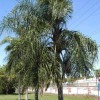 The queen palm is a popular feather-leaved palm with graceful arching leaves. It is one of the hardiest of the tropical-looking palms, being suitable for planting in USDA plant hardiness zone 9B (>25°F). Queen palms are considered to be moderately tolerant of salt spray. This 5-page fact sheet was written by Timothy K. Broschat, and published by the UF Department of Environmental Horticulture, October 2013.
The queen palm is a popular feather-leaved palm with graceful arching leaves. It is one of the hardiest of the tropical-looking palms, being suitable for planting in USDA plant hardiness zone 9B (>25°F). Queen palms are considered to be moderately tolerant of salt spray. This 5-page fact sheet was written by Timothy K. Broschat, and published by the UF Department of Environmental Horticulture, October 2013.
http://edis.ifas.ufl.edu/st609
Sabal palmetto: Sabal or Cabbage Palm
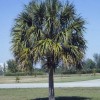 The sabal palm, or cabbage palm, is native to Florida and coastal regions of North and South Carolina and Georgia, and is the state tree of both South Carolina and Florida. The name “cabbage palm” comes from its edible immature leaves, or “heart,” which has a cabbage-like flavor. This 5-page fact sheet was written by T. K. Broschat, and published by the UF Department of Environmental Horticulture, July 2013.
The sabal palm, or cabbage palm, is native to Florida and coastal regions of North and South Carolina and Georgia, and is the state tree of both South Carolina and Florida. The name “cabbage palm” comes from its edible immature leaves, or “heart,” which has a cabbage-like flavor. This 5-page fact sheet was written by T. K. Broschat, and published by the UF Department of Environmental Horticulture, July 2013.
http://edis.ifas.ufl.edu/st575
FOR253/FR315 Livistona decipiens, Ribbon Fan Palm
FOR253, a 2-page fact sheet by Mary McKenzie, Michael G. Andreu, Melissa H. Friedman, and Heather V. Quintana, describes this tall and stately palm tree with draping leaves that can add a graceful touch to any yard. — scientific and common names, description, allergen, and applications. Includes references. Published by the UF School of Forest Resources and Conservation, May 2010.
http://edis.ifas.ufl.edu/fr315
FOR252/FR314 Phoenix dactylifera, Date Palm
FOR252, a 2-page fact sheet by Melissa H. Friedman, Michael G. Andreu, Heather V. Quintana, and Mary McKenzie, describes this palm whose fruit has been a main food source to people in the Middle East for at least 1000 years — scientific and common names, description, allergen, and applications. Includes references. Published by the UF School of Forest Resources and Conservation, May 2010.
http://edis.ifas.ufl.edu/fr314
FOR251/FR313 Ptychosperma elegans, Solitaire Palm
FOR251, a 2-page fact sheet by Heather V. Quintana, Michael G. Andreu, Melissa H. Friedman, and Mary McKenzie, describes this small palm tree native to eastern Queensland that is good to use in small residential yards because it does not require much growing space — scientific and common names, description, allergen, and applications. Includes references. Published by the UF School of Forest Resources and Conservation, May 2010.
http://edis.ifas.ufl.edu/fr313
FOR242/FR304 Wodyetia bifurcata, Foxtail Palm
FOR242, a 2-page fact sheet by Mary McKenzie, Michael G. Andreu, Melissa H. Friedman, and Heather V. Quintana, describes this palm is endemic to the scrublands of the rocky northeastern peninsula of Australia — scientific and common names, description, and applications. Includes references. Published by the UF School of Forest Resources and Conservation, May 2010.
http://edis.ifas.ufl.edu/fr304
FOR247/FR309 Dypsis lutescens, Areca Palm
FOR247, a 2-page fact sheet by Melissa H. Friedman, Michael G. Andreu, Heather V. Quintana, and Mary McKenzie, describes this common landscape plant that survives best where the average annual low temperature ranges from 35 to 40°F – scientific and common names, description, and applications. Includes references. Published by the UF School of Forest Resources and Conservation, May 2010.
http://edis.ifas.ufl.edu/fr309
FOR246/FR308 Phoenix sylvestris, Wild Date Palm
FOR246, a 2-page fact sheet by Robert J. Northrop, Michael G. Andreu, Melissa H. Friedman, Mary McKenzie, and Heather V. Quintana, describes this slow-growing palm native to India and southern portions of Pakistan – scientific and common names, description, allergen, and applications. Includes references. Published by the UF School of Forest Resources and Conservation, May 2010. http://edis.ifas.ufl.edu/fr308
FOR240/FR302 Dypsis decaryi, Triangle Palm
FOR240, a 2-page fact sheet by Heather V. Quintana, Michael G. Andreu, Melissa H. Friedman, and Mary McKenzie, describes this palm with a distinctive triangular shape to its trunk, which is endemic to the southeasternmost part of Madagascar and thrives in poor, dry soils– scientific and common names, description, allergen, and applications. Includes references. Published by the UF School of Forest Resources and Conservation, May 2010.
http://edis.ifas.ufl.edu/fr302
FOR245/FR307 Hyophorbe lagenicaulis, Bottle Palm
FOR245, a 2-page fact sheet by Melissa H. Friedman, Michael G. Andreu, Heather V. Quintana, and Mary McKenzie, describes this palm with a bottle shaped trunk that is endemic to the Mascarene Islands east of Madagascar, and can grow in south Florida — scientific and common names, description, and applications. Includes references. Published by the UF School of Forest Resources and Conservation, May 2010. http://edis.ifas.ufl.edu/fr307
